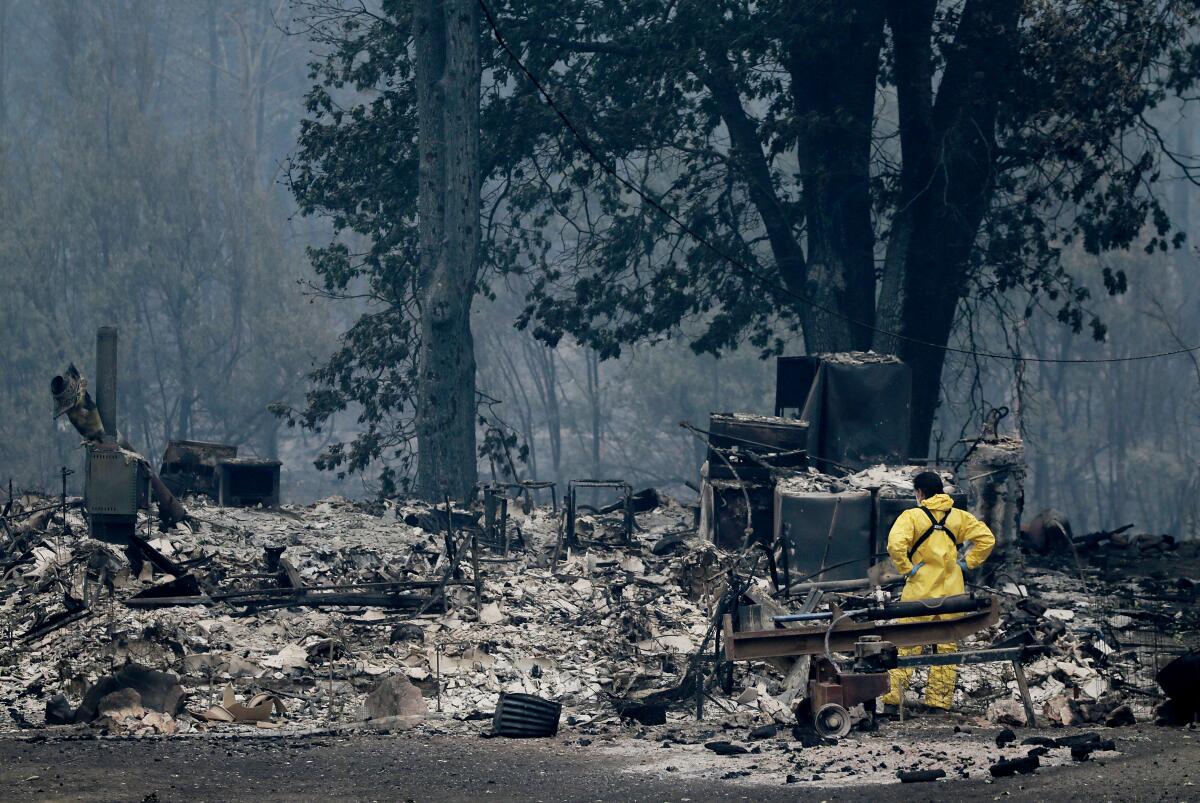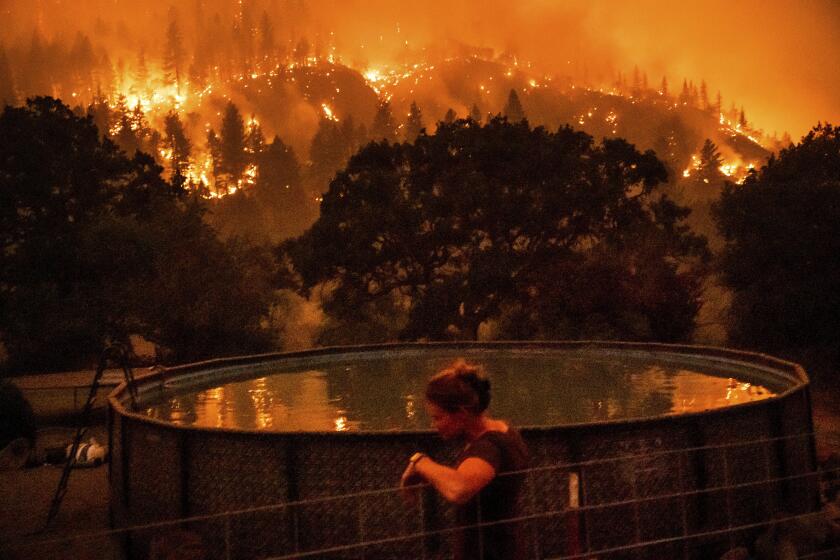Death toll in huge McKinney fire hits 4; storms could bring floods, debris flows, lightning

- Share via
YREKA, Calif. — The death toll in California’s largest fire of the year rose to four after authorities found the bodies of two additional people, officials said Tuesday, as incoming thunderstorms raised the threat of flash flooding and debris flows.
The bodies were discovered at homes along Highway 96 in rural Siskiyou County, authorities said. Two other people were found dead in a burning vehicle within the McKinney fire zone earlier in the week.
The Siskiyou County Sheriff’s Office said no more information would be available about the victims until relatives had been notified. Authorities said no one was known to be missing from the fire zone.
The McKinney fire near the Oregon border has burned more than 51,000 acres in the Klamath National Forest.
The growth of the main fire, which has burned 56,459 acres and is 0% contained, has stalled in the last two days as more firefighters arrived and weather conditions became more favorable.
The blaze gained 294 acres Tuesday, said Mike Lindbery, a public information officer assigned to the fire.
“Last night we had a nice drizzle over the fire all night long,” Lindbery said. “With humidity like that we took a good opportunity to get some direct line cut.”
Though a second day of cooler weather and higher humidity brought some relief to about 1,300 firefighters battling the blaze, thunderstorms could present new dangers.
“There is a red flag warning for abundant lightning over dry fuels,” fire spokesman Joel Brumm said. “Some of those storms may be wet — that can help — but they’re also going to potentially produce really strong outflow winds, and there could be additional lightning, which is not helpful. It wouldn’t take much for the fire to spring back to life.”
About 10 smaller fires — including the nearly 2,500-acre China-2 fire — are burning in Klamath National Forest. Those lightning fires are now being dubbed the Yeti Complex, Brumm said.
In addition to the threat of lightning, the storms raise the risk of flash flooding and debris flows in the burn zones.
The National Weather Service in Medford, Ore., issued a flash flood watch effective until 11 p.m. Tuesday.
Each storm cell could potentially drop 1 to 3 inches of rain, said Connie Clarstrom, a senior meteorologist with the weather service in Medford. “That would be enough to cause debris flows if they occur over the burn scars,” she said.
A line of storms was bringing heavy rainfall to the area Tuesday night, and officials expected to see about an inch of precipitation over parts of the burn area, said Lindbery, who added: “We’re going to be watching this very carefully tonight.”
The heavier rain started as daytime fire crews were pulling out and nighttime crews were in a briefing, Lindbery said.
Forecasters expect western Siskiyou County, where the McKinney and nearby Yeti Complex fires are burning, to see a slight chance of thunderstorms through Friday, though Clarstrom said Wednesday and Friday were “the days to watch.”
A debris flow is a crashing torrent of mud, rocks and tree branches. These rumbling, sudden movements of land and water can overwhelm homes and vehicles.
Areas recently burned by wildfires are particularly susceptible during intense rain. Vegetation on a healthy hillside typically anchors the soil even when it rains. But when a fire consumes this vegetation, the slopes — now stripped of protection — become vulnerable to erosion and fast-moving water.
Wildfires also make it harder for water to infiltrate the top layer of soil: Ash and other particles tend to clog the soil, and oily substances can affect the ground’s ability to absorb water.
The McKinney fire ignited Friday afternoon near Highway 96 and McKinney Creek Road, southwest of the Klamath River near the California-Oregon state line.
The cause of the fire is under investigation.
The McKinney fire has ripped through 52,498 acres in Klamath National Forest. A red flag warning is in effect, and storms are expected.
After a community meeting Monday night, resident Sherri Marchetti-Perrault described her harrowing story of escaping the flames.
Marchetti-Perrault told The Times that her home off Highway 96 had been destroyed in the blaze.
“When we left, everything was on fire,” she recalled. “It happened so fast. We left with the clothes on our back. We couldn’t breathe, and we couldn’t see.”
She thought of her 78-year-old uncle who was in the house with her at the time and refused to leave. She fears he was killed.
“I know where he was sitting, and I saw him,” Marchetti-Perrault said. “I’m sure it was him.”
Explosive growth of the deadly McKinney fire was driven by a perfect storm of extreme heat, dry vegetation, steep terrain and erratic winds.
An anxious wait has set in for some residents, including Bill Robberson, whose home in Yreka is two properties away from the mandatory evacuation zone.
Robberson lingered in a nearly empty historic downtown Yreka as he enjoyed a quiet cup of coffee at a table on Miner Street.
The 60-year-old lifelong Siskiyou County resident said it was hard not to be concerned by the increased frequency of wildfires in Northern California.
“As a kid we very seldom worried that fires would get out of control and take out whole towns,” he said, adding that fire season had become the de facto “fifth season” in the area each year.
“The impact environmentally, economically — and the smoke — it’s difficult to think about,” he said. “And this doesn’t help tourism. You don’t want to be known as a place that burns.”
More to Read
Sign up for Essential California
The most important California stories and recommendations in your inbox every morning.
You may occasionally receive promotional content from the Los Angeles Times.



















